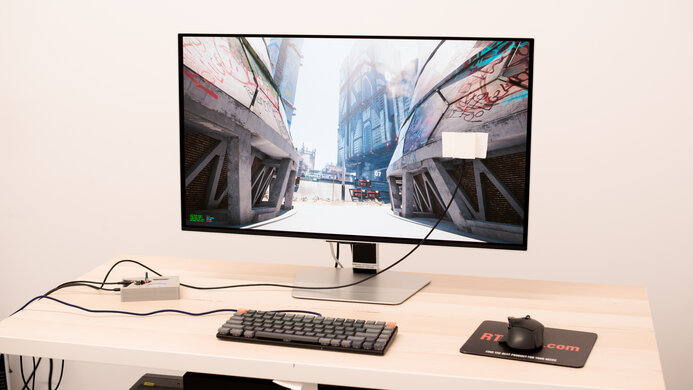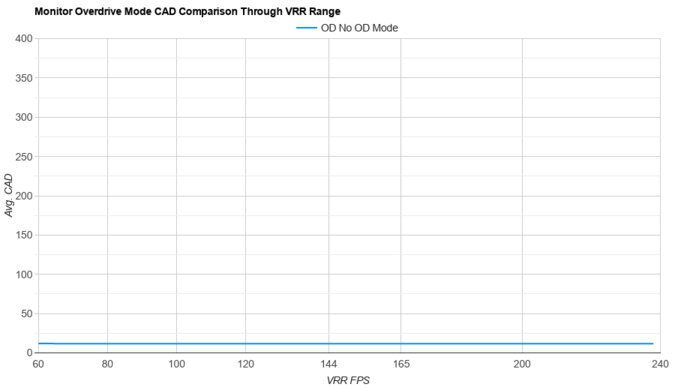
4k gaming monitors are great choices for an immersive gaming experience as they display detailed and sharp images. They're also becoming more popular and easier to find than in the past, including at different price points. However, they're more costly than lower-resolution displays, and while there are some cheap 4k options available, they're usually focused on productivity and have limited gaming performance.
For the best gaming experience, you'll want something with HDMI 2.1 bandwidth to take full advantage of sources like gaming consoles and the latest graphics cards. Although it requires a powerful graphics card to maintain high frame rates with a 4k resolution, some 4k monitors are available with high refresh rates, even up to 240Hz. These monitors are even useful for consoles like the PS5 and Xbox Series X|S. It's also important to consider the monitor's response time for crisp motion and low input lag for a responsive feel, but most monitors have low input lag anyway. Displays with a high contrast and bright highlights for good picture quality also help improve your gaming experience with realistic images.
We've bought and tested more than 330 monitors, and below are our picks for the best gaming monitors to buy with a 4k resolution. Also, see our recommendations for the best monitors for Xbox Series X, the best monitors for PS5/PS5 Pro, and the best 4k 144Hz monitors.
-
Best 4k Gaming Monitor
PC Gaming9.1Console Gaming9.4Performance Usages: Brightness6.8Response Time9.8HDR Picture9.4SDR Picture10Color Accuracy8.3Size32"Pixel TypeQD-OLEDMax Refresh Rate240 HzNative Resolution3840 x 2160The best 4k gaming monitor we've tested is the Samsung Odyssey OLED G8/G80SD S32DG80. It's a class-leading QD-OLED monitor with a 4k, 240Hz display. Gaming feels incredible, as it has an outstanding response time for incredibly sharp motion. The monitor also supports all common VRR formats to reduce screen tearing and has HDMI 2.1 bandwidth, so it can take full advantage of modern gaming consoles and graphics cards. While you need a very high-end graphics card to reach the max refresh rate at 4k, the monitor performs extremely well even at lower refresh rates.
On top of that, its picture quality is outstanding as colors are vivid alongside deep and inky blacks without any blooming, and HDR highlights get bright enough to truly pop. This is the main advantage of getting a high-end QD-OLED display, and it's also good if you want to use it in a bright room, thanks to its matte screen coating that diffuses light well. However, if you aren't a fan of the haziness of the matte coating, the MSI MPG 321URX QD-OLED is a similar QD-OLED with a glossy coating instead, but it can be harder to find at times.
-
Best Upper Mid-Range 4k Gaming Monitor
PC Gaming8.2Console Gaming8.7Performance Usages: Brightness7.7Response Time8.3HDR Picture7.8SDR Picture8.2Color Accuracy8.8Size32"Pixel TypeVAMax Refresh Rate240 HzNative Resolution3840 x 2160If you find the Samsung Odyssey OLED G8/G80SD S32DG80 too much out of your price range, the Samsung Odyssey Neo G8 S32BG85 is a great alternative that you can get for less. It has a 240Hz refresh rate like the G80SD, but the main trade-off is that it doesn't have a QD-OLED panel. This means it doesn't display the same deep blacks without any blooming as on the higher-end Samsung, and the colors are less vivid, too. That said, it still has good picture quality in HDR with decent Mini LED local dimming, making small highlights stand out.
Although this monitor doesn't deliver the same near-instantaneous response time as the G80SD either, motion still looks sharp thanks to its fast response time across its VRR range. It also has features you'd expect to find in a gaming monitor, like VRR support and HDMI 2.1 bandwidth. Its high refresh rate is ideal even for competitive gaming, but if you don't need such a high refresh rate, the Samsung Odyssey Neo G7 S32BG75 is a good alternative that you can find for a bit less with a lower 165Hz refresh rate.
-
Best Mid-Range 4k Gaming Monitor
PC Gaming7.7Console Gaming8.5Performance Usages: Brightness8.8Response Time7.9HDR Picture7.2SDR Picture7.2Color Accuracy9.0Size27"Pixel TypeIPSMax Refresh Rate160 HzNative Resolution3840 x 2160If you're looking for a cheaper 4k gaming monitor in the mid-range price category, check out the Acer Nitro XV275K P3biipruzx instead. It has a lower refresh rate than the Samsung Odyssey Neo G8 S32BG85, which is the trade-off as you drop down price categories. However, it has similar picture quality to the Samsung because it also has Mini LED backlighting, but it has a lower native contrast ratio, so blacks look gray against bright highlights if you don't use local dimming.
That said, it's still a good gaming monitor that has a fast response time, so motion looks consistently sharp at any refresh rate. It also supports any type of VRR format, and with HDMI 2.1 bandwidth, there aren't any compatibility issues with gaming consoles and modern graphics cards. The main downside is that it has increased input lag at 60Hz, which is disappointing for console gaming. However, that isn't an issue if you start gaming at higher refresh rates and use VRR to go down to 60Hz.
-
Best Budget 4k Gaming Monitor
PC Gaming7.2Console Gaming8.1Performance Usages: Brightness8.0Response Time7.7HDR Picture5.6SDR Picture6.3Color Accuracy8.7Size27"Pixel TypeIPSMax Refresh Rate160 HzNative Resolution3840 x 2160There are a few options you can choose from if you're looking for the best budget 4k gaming monitors. Although entry-level 4k gaming monitors tend to cost more than other simple 4k monitors, like those meant for office use, they're getting cheaper and are worth getting for gaming. If that's what you're interested in, the Gigabyte M27U is a good choice, but there are a few trade-offs versus the Acer Nitro XV275K P3biipruzx. The main difference is that it doesn't have Mini LED backlighting or a local dimming feature, so the picture quality is a lot worse, but that's what you have to expect for a budget-friendly monitor.
Despite the difference in picture quality, it's still good enough for gaming, with a fast response time at most refresh rates. It has the same 160Hz refresh rate as the Acer, so it's still good enough for most gamers and supports HDMI 2.1 bandwidth. Its input lag at 60Hz is also lower than the Acer, which is great for playing reaction-based games, like on consoles.
Notable Mentions
- Dell Alienware AW3225QF:
The Dell Alienware AW3225QF is a high-end 4k, 240Hz QD-OLED that competes with the Samsung Odyssey OLED G8/G80SD S32DG80. It's a good alternative if you want something with more accurate colors, but it has a curved screen that may not be for everyone.
See our review - LG 32GS95UE-B:
The LG 32GS95UE-B is a premium 4k, 240Hz monitor that's different from the Samsung Odyssey OLED G8/G80SD S32DG80. It has a Dual-Mode feature that boosts the refresh rate to 480Hz with a 1080p resolution. This is useful if you're a competitive gamer, but the lower resolution delivers less detailed images than at 4k.
See our review - Sony INZONE M9:
The Sony INZONE M9 is a good mid-range option that has lower input lag at 60Hz than the Acer Nitro XV275K P3biipruzx, making it great for console gaming. However, it has worse picture quality than the Acer and can be harder to find.
See our review - MSI MAG 274UPF:
The MSI MAG 274UPF is a budget monitor that's
similar to the Gigabyte M27U and has a few extra features like higher power delivery over USB-C. It's worth considering, but only if you can find it available because it's hard to find.
See our review
Recent Updates
-
We only made changes in the Notable Mentions to reflect the current 4k gaming monitor market. We replaced the ASUS ROG Swift OLED PG32UCDM with the Dell Alienware AW3225QF and added the LG 32GS95UE-B.
-
Sep 10, 2024: We replaced the Dell Alienware AW3225QF with the Samsung Odyssey OLED G8/G80SD S32DG80 for consistency with other recommendations. We also replaced the LG 27GR93U-B with the Gigabyte M27U in the budget category because the Gigabyte is cheaper. Lastly, in the Notable Mentions, we added the MSI MAG 274UPF and replaced the GIGABYTE AORUS FO32U2P with the ASUS ROG Swift OLED PG32UCDM because the Gigabyte is hard to find.
-
Jun 21, 2024: Added the Gigabyte AORUS FO32U2P to the Notable Mentions to better represent the current 4k gaming market.
-
May 03, 2024: Replaced the LG 32GR93U-B with the Acer Nitro XV275K P3biipruzx in the 'Best Mid-Range' category to reflect market position. Also replaced the Gigabyte M27U with the LG 27GR93U-B for consistency with other recommendations and moved the Gigabyte to Notable Mentions. Replaced the Gigabyte M32U with the Sony INZONE M9 in the Notable Mentions.
-
Mar 04, 2024: Confirmed that our selections are consistent and up-to-date.
All Reviews
Our recommendations are based on what we think are the best gaming monitors with a 4k resolution currently available. They're adapted to be valid for most people in each price range. Rating is based on our review, factoring in price, and feedback from our visitors.
If you would prefer to make your own decision, here is the list of all of our 4k monitor reviews. Be careful not to get too caught up in the details. Most monitors are good enough to please most people, and the things we fault monitors on are often not noticeable unless you really look for them.















